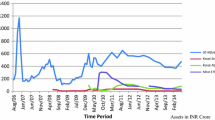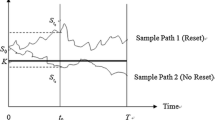Abstract
This article investigates the pricing behavior of national index funds (NIFs). Under barriers to capital flows in an otherwise perfect capital market, the familiar result of zero premium/discount obtains. The more realistic assumption of imperfect cross-border arbitrage suggests that in a two country setting the NIFs will sell at a premium. In a multicountry framework, the investment barriers will result in NIFs generally trading at a premium, although theoretically one cannot rule out a discount from net asset value (NAV). A simple test supports the proposition that under investment barriers, NIFs should trade at a premium to NAV after controlling for the average domestic closed-end fund discount.
Similar content being viewed by others
References
Black, F., “International Capital Market Equilibrium With Investment Barriers,”Journal of Financial Economics, 1, 337–352 (1974).
Bonser-Neal, C., Brauer, G., Neal R., and Wheatley, S. “International Investment Restrictions and Closed-end Country Fund Prices,”Journal of Finance, forthcoming (1990).
Brauer, G., “Open-Ending Closed-End Funds,”Journal of Financial Economics, 13, 491–508 (1984).
Cooper, I., and Kaplanis, C., “Costs to Crossborder Investment and International Equity Market Equilibrium,” in Edwards et al. (eds.),Recent Developments in Corporate Finance, New York, Cambridge University Press (1986).
Errunza, V., and Senbet, L., “The Effects of International Operations on the Market Value of the Firm: Theory and Evidence,”Journal of Finance, 36, 401–417 (1981).
Errunza, V., and Losq, E. “International Asset Pricing Under Mild Segmentation: Theory and Test,”Journal of Finance, 40, 105–124 (1985).
Errunza, V., and Losq, E., “Capital Flow Controls, International Asset Pricing and Investor's Welfare: A Multicountry Framework,”Journal of Finance, 44, 1025–1037 (1989).
Eun, C., and Janakiramanan, S., “A Model of International Asset Pricing with a Constraint on the Foreign Equity Ownership,”Journal of Finance, 41, 897–914 (1986).
Lessard, D., Bollier, T., Eckaus, R., and Kahn, R., “Country Risk, Capital Market Integration and Project Evaluation: A Canadian Perspective,” mimeo, Sloan School of Management, MIT (1983).
Malkiel, B., “The Valuation of Closed-End Investment Company Shares,”Journal of Finance, 32, 847–859 (1977).
Stulz, R., “On the Effects of Barriers to International Investment,”Journal of Finance, 36, 923–934 (1981).
Thompson, R., “The Information Content of Discounts and Premiums on Closed-End Fund Shares,”Journal of Financial Economics, 6, 151–186 (1978).
Subrahmanyam, M., “On the Optimality of International Capital Market Integration,”Journal of Financial Economics, 2, 3–28 (1975).
Author information
Authors and Affiliations
Rights and permissions
About this article
Cite this article
Errunza, V.R. Pricing of national index funds. Rev Quant Finan Acc 1, 91–100 (1991). https://doi.org/10.1007/BF02408408
Issue Date:
DOI: https://doi.org/10.1007/BF02408408




